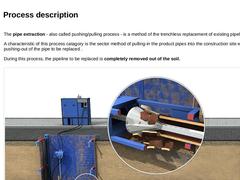
|

|
The pipe extraction - also called pushing/pulling process - is a method of the trenchless replacement of existing pipelines. A characteristic of this process catagory is the sector method of pulling-in the product pipes into the construction site with the aid of a hydraulic pulling-equipment situated in the target excavation with the simultaneous pushing-out of the pipe to be replaced . During this process, the pipeline to be replaced is completely … |
|
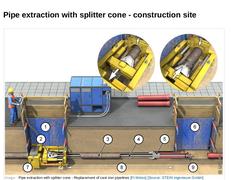
|

| (Image: Pipe extraction with splitter cone - Replacement of cast iron pipelines [FI-Weiss])
|
|
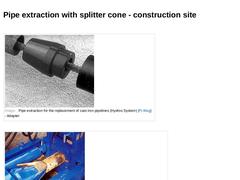
|

| (Image: Pipe extraction for the replacement of cast iron pipelines (Hydros System) [FI-Klug] - Adapter) (Image: Pipe extraction for the replacement of cast iron pipelines (Hydros System) [ATVA127a] - Splitter cone) |
|
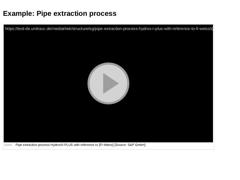
|

Example: Pipe extraction process Hydros®-Plus |

|

| (Image: Attention!) Preconditions for the application of pipe extraction: - Circular pipe cross sections
- Preferably brittle pipe materials
- Displaceable soil in the embedment for cross-sectional enlargement
- Straight-lined section
| (Table: Pipe extraction - Possible materials of the old and new pipeline [FI-Steina]) |
|
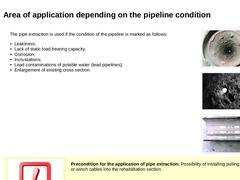
|

|
The pipe extraction is used if the condition of the pipeline is marked as follows: - Leakiness;
- Lack of static load bearing capacity;
- Corrosion;
- Incrustations;
- Lead contaminations of potable water (lead pipelines);
- Enlargement of existing cross section.
| |
(Image: Steel potable water pipe with iron and manganese deposits [FI-Hermea])
|
|
(Image: Hole corrosion - pitting)
|
|
(Image: "Moving jet test " [Zimme01])
|
| | (Image: Attention!)
Precondition for the … |
|
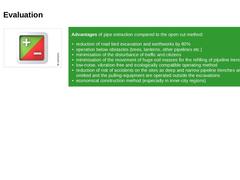
|

| (Image: Pros and cons) | Advantages of pipe extraction compared to the open cut method: - reduction of road bed excavation and earthworks by 80%
- operation below obstacles (trees, lanterns, other pipelines etc.)
- minimisation of the disturbance of traffic and citizens
- minimisation of the movement of huge soil masses for the refilling of pipeline trenches
- low-noise, vibration-free and ecologically compatible operating method
- reduction of risk of accidents …
|
|
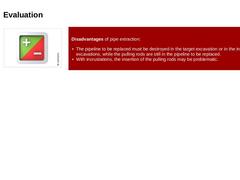
|

| (Image: Pros and cons) | Disadvantages of pipe extraction: - The pipeline to be replaced must be destroyed in the target excavation or in the intermediate excavations, while the pulling rods are still in the pipeline to be replaced.
- With incrustations, the insertion of the pulling rods may be problematic.
|
|
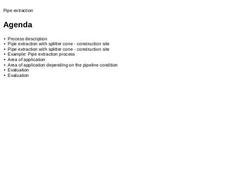
|

|
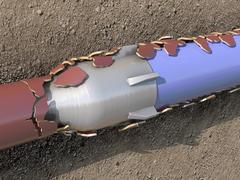
|

This lecture is part of the series "Trenchless 101" and serves to provide an overview of trenchless replacement methods for gas, water and wastewater pipelines. |
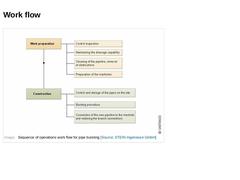
|
(Image: Sequence of operations work flow for pipe bursting) |
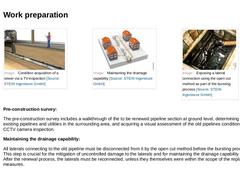
|
(Image: Condition acquisition of a sewer via a TV-inspection) (Image: Maintaining the drainage capability) (Image: Exposing a lateral connection using the open cut method as part of the bursting process) Pre-construction survey: The pre-construction survey includes a walkthrough of the to be renewed pipeline section at ground level, determining the location of existing pipelines and utilities in the surrounding area, and acquiring a visual assessment … |
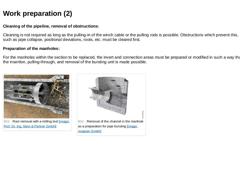
|
Cleaning of the pipeline, removal of obstructions: Cleaning is not required as long as the pulling-in of the winch cable or the pulling rods is possible. Obstructions which prevent this, such as pipe collapse, positional deviations, roots, etc. must be cleared first. Preparation of the manholes: For the manholes within the section to be replaced, the invert and connection areas must be prepared or modified in such a way that the insertion, pulling-through, … |
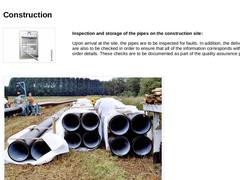
|
Inspection and storage of the pipes on the construction site: Upon arrival at the site, the pipes are to be inspected for faults. In addition, the delivery papers are also to be checked in order to ensure that all of the information corresponds with the original order details. These checks are to be documented as part of the quality assurance procedure. (Image: HD-PE discrete long pipes DA 500) |
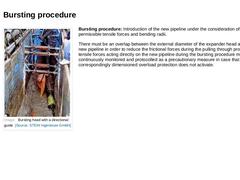
|
(Image: Bursting head with a directional guide) Bursting procedure: Introduction of the new pipeline under the consideration of the permissible tensile forces and bending radii. There must be an overlap between the external diameter of the expander head and that of the new pipeline in order to reduce the frictional forces during the pulling through procedure. The tensile forces acting directly on the new pipeline during the bursting procedure must … |
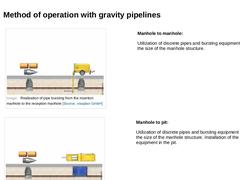
|
(Image: Realisation of pipe bursting from the insertion manhole to the reception manhole) Manhole to manhole: Utilization of discrete pipes and bursting equipment suited to the size of the manhole structure. (Image: Realisation of pipe bursting from the insertion manhole to the reception pit) Manhole to pit: Utilization of discrete pipes and bursting equipment suited to the size of the manhole structure. Installation of the pulling equipment in the pit. |
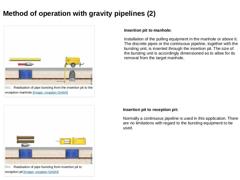
|
(Image: Realisation of pipe bursting from the insertion pit to the reception manhole) Insertion pit to manhole: Installation of the pulling equipment in the manhole or above it. The discrete pipes or the continuous pipeline, together with the bursting unit, is inserted through the insertion pit. The size of the bursting unit is accordingly dimensioned as to allow for its removal from the target manhole. (Image: Realisation of pipe bursting from insertion … |
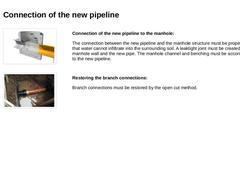
|
(Image: Connection of the new pipeline to the manhole) Connection of the new pipeline to the manhole: The connection between the new pipeline and the manhole structure must be properly sealed so that water cannot infiltrate into the surrounding soil. A leaktight joint must be created between the manhole wall and the new pipe. The manhole channel and benching must be accordingly fitted to the new pipeline. (Image: Re-connection of a lateral to the new … |
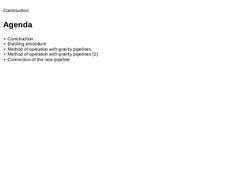
|
|

|
|
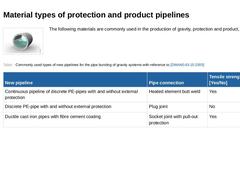
|
(Image: Gravity pipeline) The following materials are commonly used in the production of gravity, protection and product, pipelines: (Table: Commonly used types of new pipelines for the pipe bursting of gravity systems with reference to [DWAM143-15]) |
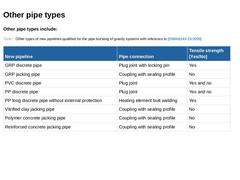
|
Other pipe types include: (Table: Other types of new pipelines qualified for the pipe bursting of gravity systems with reference to [DWAM143-15]) |
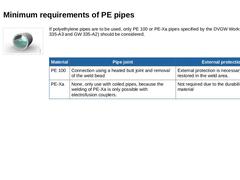
|
(Image: Gravity pipeline) If polyethylene pipes are to be used, only PE 100 or PE-Xa pipes specified by the DVGW Worksheet (GW 335-A3 and GW 335-A2) should be considered. |
Material |
Pipe joint |
External protection |
|
PE 100 |
Connection using a heated butt joint and removal of the weld bead |
External protection is necessary and is to be restored in the weld area. |
|
PE-Xa |
None, only use with coiled pipes, because the welding of PE-Xa is only possible with … |
|
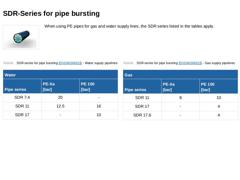
|
(Image: Rohricon) When using PE pipes for gas and water supply lines, the SDR series listed in the tables apply. (Table: SDR-series for pipe bursting - Water supply pipelines) (Table: SDR-series for pipe bursting - Gas supply pipelines) |
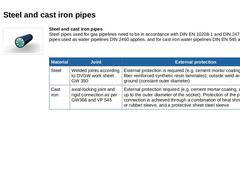
|
(Image: Rohricon) Steel and cast iron pipes
Steel pipes used for gas pipelines need to be in accordance with DIN EN 10208-1 and DIN 2470-1. For steel pipes used as water pipelines DIN 2460 applies, and for cast iron water pipelines DIN EN 545 applies. |
Material |
Joint |
External protection |
|
Steel |
Welded joints according to DVGW work sheet GW 350 |
External protection is required (e.g. cement mortar coating or glass fiber reinforced synthetic resin … |
|